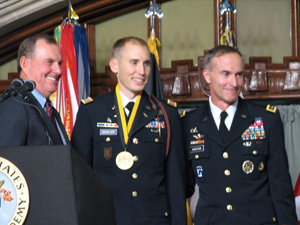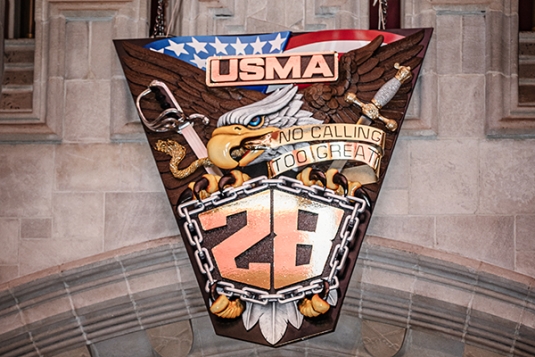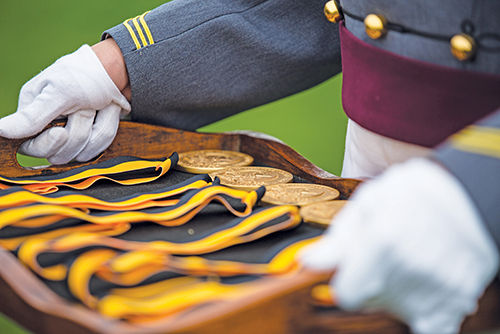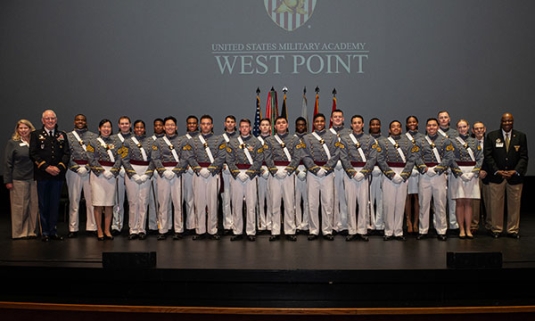Captain Robert Sickler class of 2005 received the 5th annual West Point Association of Graduates Alexander R. Nininger Award Wednesday, Sept. 15, during an awards ceremony at West Point.
CPT Sickler received the Distinguished Flying Cross for valor as an Air Mission Commander on Dec. 30, 2007, during Operation Iraqi Freedom while engaged in direct action with the enemy in Mosul, Iraq. The citation reads:
On 30 December 2007, 1LT Robert I. Sickler distinguished himself by exceptional valor as the Air Mission Commander (AMC) of a Scout Weapons Team(SWT) in direct action with the enemy. 1LT Sickler’s flight of two OH-58D helicopters was conducting reconnaissance in Mosul, Iraq when he was directed to engage a van with enemy personnel that had been observed transferring weapons and test-firing a large caliber machine gun. The SWT tracked the van through a residential neighborhood and engaged it when it stopped in a lightly populated area. 1LT Sickler lased the target while the second OH-58D fired a Hellfire missile. 1LT Sickler skillfully guided the missile to destroy the van, the heavy machine gun, and four enemy personnel. As the SWT closed on the destroyed van, 1LT Sickler’s OH-58D was struck by rifle and machine gun fire that knocked out all communications and seriously damaged the helicopter. In spite of imminent engine failure, 1LT Sickler and his pilot were able to successfully return to base. While the pilot shut down the damaged aircraft, 1LT Sickler ran to a waiting OH-58D and prepared for take-off. Back in the air, the SWT was notified of a follow on target from the earlier engagement. Still the AMC, and now flying the aircraft as pilot, 1LT Sickler led his SWT to attack the enemy vehicle with a Hellfire that struck the vehicle causing it to swerve off the road and the enemy to evacuate it. 1LT Sickler continued to engage the enemy with rockets, killing several. His actions and those of his SWT resulted in eight enemy insurgents killed and two vehicles and a heavy machine gun destroyed. 1LT Sickler’s leadership and bravery under fire undeniably disrupted and hindered future enemy actions.
Speech
GEN & MRS. Huntoon, Mr. and Mrs. Glore, GEN Trainor, COL & MRS. McClure, other distinguished guests and, of course, The Corps of Cadets. Thank you very much for this honor. I am proud to receive the Nininger Award on behalf of my fellow soldiers.
I would like you all to know I never could have imagined that just five years after graduating I would be addressing you here in the mess hall. It really does seem like just yesterday I was sitting where you are right now. Also, I would like you to know that, As a cadet, I wasn’t outstanding. I didn’t wear gold stars on my collar, and I wasn’t on a corps squad team. I was certainly never in the running to be First Captain. But I did walk across the stage at Michie Stadium—just as you will—received my diploma, and began my career as an army aviator. A few months later, shortly after flight school, I was deploying with my unit to Iraq.
You could say my army career began in earnest with my first combat flight above Mosul, Iraq. It’s a crowded city, with about 2 million people. About an hour into that first mission, our scout weapons team, operating in two OH-58D Kiowa warriors, spotted two bodies below us they were lying in the middle of a busy street. As we flew over the area a second time, gunfire erupted from a nearby building; we realized the enemy had set a trap. Next, I heard rounds cracking over the radio and another pilot screaming, “Popcorn, popcorn—breaking right.”
Immediately, my pilot dove our aircraft toward the building and fired two rockets at a range of 200 meters. I, on the other hand, was trying to figure out what popcorn meant. Then, I knew: small arms fire was all around us. It sounded like popcorn in a microwave oven. As we pulled sharply away, I kept thinking, “Man, I should be doing something.” So, I reached for my M4, then I thought—“Maybe I shouldn’t do that—It might get in the way.” So, I grabbed the side of the door and started to poke my head out—to see what was going on, and thought, “Maybe I shouldn’t be hanging out of the aircraft right now.” So, I sat back and realized I didn’t know what to do with my hands. I felt like Ricky Bobby being interviewed after a race. In the minutes that followed, I watched the pilots of our two aircraft, working as a team. They stayed out of enemy range, maintained contact, and, eventually, destroyed the enemy. I realized I had a lot to learn. Over the next few months, I did learn—from veteran pilots, from my own mistakes, and from our after-action reviews.
Soon, I became a Pilot in Command and an Air Mission Commander, positions based on ability, not rank. And that brings us to the morning of 30 December 2007 and the action outlined in your program. That morning, I was the Air Mission Commander of the mid-day Scout Weapons Team—two OH 58D Kiowa warriors. A Kiowa is like a small traffic helicopter – with hellfire missiles, rockets, .50 caliber machine gun, and a laser range finder designator. CPT Pete Digiorgio West Point class of 2000 was assigned to fly my Kiowa. Chief Warrant Officers Tom Boise and Susan Weathers were in the trail aircraft in our team.
After morning briefings, the four of us went into the operations center. There, on a big-screen TV, was video of a black van. The video was being transmitted from a camera on a Predator—an Unmanned Aerial system—high above Mosul. We learned that the occupants of the van had been loading weapons, and test-firing a heavy machine gun in a junkyard. Another scout weapons team was in the air, tracking the van, but about to run out of fuel and we were on call to relieve them.
My team ran to the flight line, and minutes later, we were flying at low level in the hazy sunshine over Mosul, stalking the black van. Tracking and engaging a specific black van out of probably 50 thousand black vans in a crowded city is not easy. You don’t want to lose sight of the enemy, but you can’t get too close and scare him off, either collateral damage is a concern and buildings, power lines, and other obstructions greatly limit opportunities to fire. So—Teamwork is critical. The video feed from the predator guided our maneuvers. If the black van disappeared behind a building or made a U-turn, the ground operator observing the video would talk us back to the target. Twice, we were cleared to fire but buildings or power lines obstructed my line of sight. After two hours, the van returned to the junkyard, and we were cleared to engage the van with a hellfire. a white car right next to the van was also designated as a secondary target as we maneuvered, I placed the laser’s crosshairs on the driver’s side door. It was a shot that would destroy the van and also damage the white car. I called over the radio, “Spot on.” From the other aircraft, TOM Boise replied, “Solid box”—meaning his missile had locked on the target. Seconds later, a Hellfire was racing from the rail on Tom’s aircraft. While I held the crosshairs on the van, CPT Digorgio precisely steadied our aircraft during the 15 seconds to impact. However, Just before our Hellfire struck, the white car drove away from the van, separating by about 20 meters.
The van then exploded in a giant cloud of dust, its hood flying over 100 feet into the air. As the dust cleared, our helicopters moved as a team in a clockwise orbit around the target. Over the radio we heard that 20 armed men were pulling weapons out of the wreck of the black van and some of them appeared to be firing in our direction we were cleared us to engage the enemy with our .50 cal MACHINE gun. CPT Digorgio and I dove to an altitude of about 25 feet . . . lower than the ceiling here in Washington Hall. We positioned our Kiowa with a small hill between us and the enemy. A Kiowa has fixed guns, so the pilot must point the aircraft directly at the target, like a World War Two fighter. About 500 meters from the junkyard—the distance from here to Trophy Point— CPT Digorgio pulled back on the controls and we gained altitude, preparing to attack. We crested the hill into the sound of bullets cracking past the cockpit. CPT Digorgio nosed the aircraft over the top of the hill, and we saturated the junkyard with .50 CAL.
The enemy fell silent, but high-tension wires caused us to pull out of the attack early. Then, I heard the popcorn—this time, it was “ping, ping, pong.” Several 762 rounds had hit our aircraft. One of them cut a bundle of wires between our seats and shut down our electronics. Now, the radios were silent and the displays went black. I couldn’t even hear CPT Digiorgio in the seat next to me. We prepared to auto-rotate into a cemetery. I remember seeing a large headstone in front of us and thinking, “Man, this is going to hurt.” However, as we locked our seatbelts, preparing for a hard landing, our aircraft’s systems began to reset. We seemed to have a strong engine but didn’t know how long it would last. CPT Digorgio pulled us up over buildings surrounding the cemetery and I troubleshot the radios. The intercom system was still out, oil pressure warnings were flashing, and something was burning . . . so—we headed back towards our airfield, flying low over the roads. If the engine quit at least we would crash into a road—not the side of a building. Once again, I felt I should be doing something, and decided to drop smoke grenades from our aircraft to mark our path back to the airfield, thinking friendly forces might find us if we went down. Sure enough, Susan and Tom read our signals and coordinated our clearance to land. As we flew over the wire surrounding our airfield, I distinctly remember thinking . . . “we might actually pull this off.”
When we landed, CPT Digorgio quickly shut down our aircraft and I hustled to another one on the flight line. For us, quitting was not an option there were still bad guys out there. We wanted to continue the mission! In minutes, we were linking up with Tom and Susan in the center of the airfield. There, we were told the men who had shot at us were moving out in the white car. Within minutes, our two-helicopter team was on the attack once again. We tracked the car for about an hour until it dashed out of the city limits into the desert, giving us a clear shot. The laser sight on my aircraft was broken, so Susan and Tom lased and fired a Hellfire missile. It struck the rear of the car. The car swerved and crashed into a sand berm. Three men scattered in various directions. My team engaged two of them and the third made it to an area where there were non-combatants. The sun was starting to set, so the Rangers decided to capture him. We learned their interrogation had yielded valuable information on other enemy cells. Finally, After over 5 hours of combat, my team stood down.
Reflecting on our experience in light of your training, I would have you note a few things about this story. First, I was one member of a team of professionals and my teammates were all critical to the outcome. Second, we had to improvise, make quick decisions, compensate for damaged equipment, and, most of all, read one another’s actions. Even when the enemy denied us communication with each other, we were able to work together and get back in the fight. So, I encourage you to make the most of any situation requiring dynamic, agile leadership and communications.
Study your teammates’ strengths and analyze their different approaches to situations. These opportunities are everywhere in cadet life. For me, it was the pistol team and being CIC of the mini-baja team. Also, know that west Point is preparing you well for your profession. After you graduate, you will continue to learn, but you will have the right stuff to meet any challenge.
In closing, I would like to thank everybody at the academy who contributed to my development. I would also like to thank my family, and, of course, my fiancé, who is here tonight.
General Huntoon and Mr. Glore, I especially appreciate the courtesies you have extended to me and to my guests.
Finally, to the Corps, thank you for your attention this evening and for your commitment to our profession. I look forward to serving with you in the years ahead.




